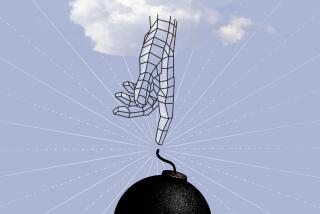Healthy Environment for Applied Science
- Share via
Convention, tradition and my editor’s polite threat all dictate that this column make predictions for the coming year. But rather than spin the usual hot technology wish lists and “people to watch” profiles, I want to discuss the single most important force now transforming technology, innovation and pop culture: “bionarcissism.” It’s an ideology as powerful and influential as capitalism and religion combined.
Doubt that? Just look at the evidence. By practically every measure, America is becoming a nation of bionarcissists--people who are relentlessly absorbed with their own sense of physical well-being. Despite strenuous efforts to manage costs, American health-care spending as a percentage of gross national product grew to more than 12% last year from more than 8.3% in 1975. New medical technologies and the graying of America guarantee that costs will continue to rise. Our pharmaceutical companies--thanks to impressive research investments and clever use of intellectual property laws--are among the most profitable manufacturing companies in the world and should continue to be.
But there’s far more to bionarcissism than big budgets and big business. Listen carefully and you’ll hear the bitterest policy debates and personal conversations swirling around the questions of bionarcissism:
What does quality health care really cost? Who should determine a Nancy Cruzan’s fate on life-support technologies? What are the best options for monitoring and managing the AIDS epidemic? Does life begin at the moment of conception or 12 weeks later? Are you too fat? Are women who drink heavily during pregnancy guilty of a crime? What drug addiction therapies work best for the poor? Should insurance companies be allowed to test for inherited genetic diseases? Do video display terminal emissions cause cancer? Who has the right to request a hospital DNR--Do Not Resuscitate--order for an aging patient in intensive care?
More than money, power or status, bionarcissists value the quality of life itself--even as they disagree on what that precisely means. Unlike the mythical Narcissus, paralyzed by the beautiful reflection of his image, being a bionarcissist means you are always looking for whatever tools, techniques, tricks and ideas are out there (serious and spurious) that can make you “feel” and be healthier--whatever the price. This isn’t selfish materialism a la Tom Wolfe “me-decade”; it’s the conspicuous consumption of “health.”
Plastic surgery and diet mixes can re-contour self-image; lasers can heal blurred vision; pills can eliminate pain and amplify energy. Perhaps clever genetic engineering will soon eradicate a chronic ailment or guarantee the birth of a “defect-free” child. A “suicide machine” offers the promise of release. It’s an ideology of hope and pragmatism that appeals to everyone who craves choice. Bionarcissism shifts our definition of personal prosperity from Adam Smith’s “Wealth of Nations” to a tantalizingly elusive “Health of Nations.”
We also see strains of bionarcissism in the environmental movements and the animal rights movement. Indeed, within the environmental movement there are bionarcissists who think that humans belong at the top of the ecosphere--man is the measure of all things--and those who argue that all species are created equal--life is the measure of all things. The point is that the divisions and arguments all revolve around, for want of a better phrase, “the meaning of life.”
But bionarcissism isn’t just an artifact of pop culture and the public health. It reaches into the very core of how we see ourselves. Where the physical sciences once dominated the intellectual landscape and physicists ruled the science policy roosts, the life sciences today now command the metaphors and vocabulary of innovation. Where computer scientists once bragged about artificial intelligence software, today they are trying to concoct algorithms for artificial life. A decade ago, silicon chip designers could only think digitally; today, they are designing silicon analogs to the retina and the cochlea.
Membership figures of the prestigious National Academy of Sciences confirm the disciplinary shift. In 1975, 35% of the members were classified as being in the life sciences; today, that number is 52%. Instead of using physical phenomena to explain organic processes, scientists today increasingly rely on organic metaphors to explain physical phenomena.
Of course, scientists--and most people, for that matter--don’t think of themselves as bionarcissists. But it’s very clear that where people were once fascinated by the “things,” people today are obsessed with “living things,” in part because we have more tools, more technologies and more issues surrounding living things than ever before.
As a culture, we are becoming less interested in building things like atomic weapons and computer systems and more interested in building life forms and tools that transform the quality of health. The idea that we are in an “Atomic Age” or an “Information Age” isn’t wrong--it just dwindles into marginalia when you consider the awesome sway that bionarcissism now holds in this culture.
Sure, people talk about their brand-new computers, their automobiles and their jobs. But listen to the tone of their voices when they start talking about health care benefits, taking a parent to the hospital and their friend who survived a heart attack. Listen to them talk about abortion and euthanasia and the crack vials littered on the city streets. What you’ll hear should confirm that the issues that people really care about reflect their basic bionarcissism. That’s not a criticism; that’s a fact.
Like all neurotic obsessions, narcissism is fundamentally unhealthy. But, ironically, that doesn’t seem to matter when it comes to bionarcissism. The issues are just too important to ignore.
Consequently, I think there is no question that our culture of bionarcissism will continue to generate a host of entrepreneurial opportunities for both profit-oriented innovators and election-oriented politicians. The middle class of this country cares very, very deeply about the quality of life. So long as technology can dangle the lure of improving it, bionarcissism will remain the most powerful ethic driving innovation in America.






